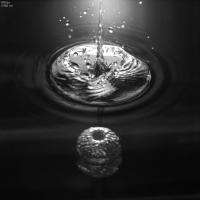What happens when a stone impacts on water

Researchers at the Foundation for Fundamental Research on Matter (FOM), the University of Twente in the Netherlands and the University of Seville in Spain have explained the formation and behaviour of the very fast water jet that is formed when an object impacts on a water surface. They have observed precisely what happens using a super-fast camera and have made a computer simulation of the process.
This shows how the jet is forced upwards, layer by layer, by the surrounding water pressure. The simulation corresponds very closely with observations. They have also formulated a theoretical model based on this that explains the extremely high speed of the water jet. The researchers are publishing their findings in the renowned journal, Physical Review Letters. These results are not only of academic significance as jets on the impact of an object on a liquid are frequent occurrences in nature and industry.
If one drops a stone into a pond, a very rapid, thin jet of water spouts upwards. This is an everyday phenomenon that occurs frequently in nature and industry. However, the rich and complex dynamics underlying such a system are only revealed if viewed using a high-speed camera. The latter shows how the downward movement of the object is converted into the upward movement of the jet. A cavity forms behind the object during impact on the water surface.
This cavity is subsequently compressed by hydrostatic pressure, which leads to the formation of the jet. In their experiments, FOM PhD candidate Stephan Gekle, José Manuel Gordillo of the University of Seville and Devaraj van der Meer and Detlef Lohse of the University of Twente demonstrate how the wall of the cavity forces the jet upward as it implodes, just like toothpaste being squeezed out of a tube, but many times faster, of course. Incidentally, a jet which is forced downward, deeper into the liquid, is also created at the same time. This second jet is not visible on the surface.
In order to examine the dynamics of the impact in a highly controlled manner, the researchers draw a circular disc through the water surface using a linear motor with a constant speed. Subsequently a high-speed camera is used to take images with a speed of up to 30,000 frames per second. The formation and constriction of the cavity and the formation of the jet can thus be followed in detail.
A computer simulation of the process - which corresponds very closely to the experiment - enables the researchers to study the resulting flow profile. It appears that the jet is forced upward, layer by layer, by the imploding wall. The researchers have formulated a theoretical model to explain the enormous speed of the water jet on the basis of this observation.
Publication: High-Speed Jet Formation after Solid Object Impact, Physical Review Letters, 23 January, 2009.
Provided by University of Twente




















